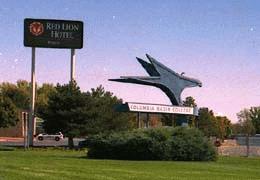On September 19, 1955, Columbia Basin College opens in Pasco as the 10th junior college in the state. The college started as a vocational-technical school in 1946 and sufficient population and demand justifies opening a new institution. On opening day, 272 students are enrolled in programs ranging from automotive mechanics to nursing.
A Post-War Vocational School
Beginning in 1946, Jack Cooney directed a vocational-technical school to train workers for the Hanford Nuclear Reservation. He used space formerly occupied by the Pasco Naval Air Station that had been decommissioned after the end of World War II. Cooney designed apprenticeship training and trade extension training, with emphasis on welding. The automotive mechanics and farming programs were also in high demand. Some students attended business, homemaking, and distributive courses. The school had about five times more night students than day students.
On May 14, 1955, the State Board of Education granted the City of Pasco authority to establish a junior college. Richland and Kennewick also vied for the honor of having the college, but when Pasco Mayor Harry Custer, the Pasco City Council, school directors Lyle Neff and Tom Bishop, and Superintendent Herman Jaeger acquired 157 acres of the former naval base to be used for the college, the deal was sealed.
The New College
When it opened for the fall quarter of 1955, the college occupied five buildings -- the old administration building from the naval base and four smaller buildings. The college moved to the new site when new structures were erected.
Of the 272 new students, just 34 were women. About 50 percent of all students enrolled in vocational programs. The remaining students enrolled in general education courses. For the most part, students had to be graduates of Washington state high schools to be admitted. If students did not need to transfer their credits to another college, they could be admitted without the high school diploma. Students from out of state who could demonstrate completion of requirements equivalent to those mandated by Washington state could be admitted.
George Askegaard took the jobs of registrar, assistant bursar, and manager of the Columbia Basin College bookstore. Mildred Partch, librarian, explained that though the new school library contained an adequate general reference collection, she had to build up the library's collection of other materials.
Walter A. Oberst, future chronicler of Pasco history, transferred from the Pasco School District to the college to teach political science and history. Harold K. Severeid and Wayne Rodgers headed up the automotive technology program. Other courses included math, English, foreign languages, speech, drama, music, science, agriculture, social science, chemistry, business education, practical nursing, and physical education. In addition to two-dozen full-time instructors, 35 to 40 part-time instructors taught courses at night.
To Pasco's Advantage
Marvin J. Nelson, Chairman of the Pasco School Board, declared the college an economic advantage to the Tri-Cities. Statistics showed that communities with a college draw more income into the area and retain more local students as future assets to the community.
The college was administered under the authority of the local public school district. This meant that the school district was responsible for funding the college. Initially the school district floated bonds and levies. The Pasco School District was responsible for the entire bill, even though many of the students resided outside Pasco. The school offered accident insurance for students in case they sustained injuries going to or from school, at school, or at school functions away from campus.
Almost as soon as Columbia Basin College opened, plans were made to erect permanent buildings. Over the second half of the 1950s, these buildings were erected on the former naval base land at the school's current location off Road 20.
When some of its permanent structures and curricula were established, auditors from the Northwest Association of Colleges and Universities, responsible for accrediting colleges and universities, visited the campus. As of December 5, 1960, the Association expressed satisfaction with the college's curricula, faculty, facilities, and operations, and accredited the institution.

